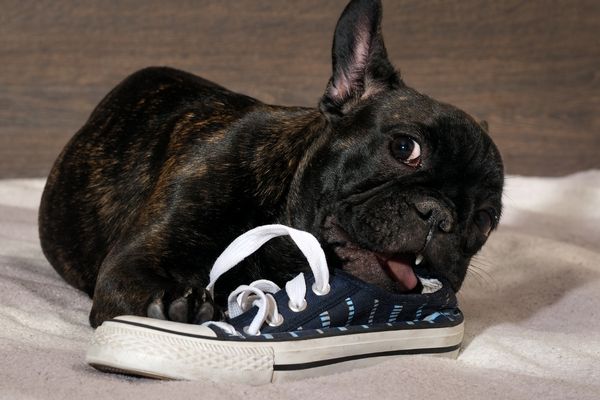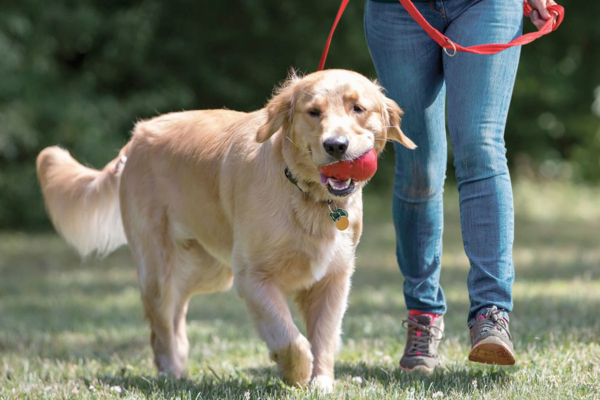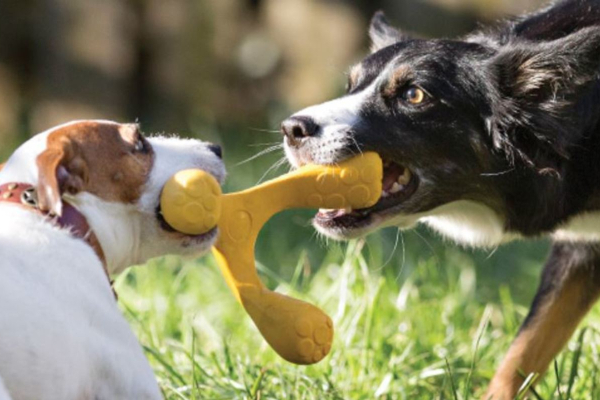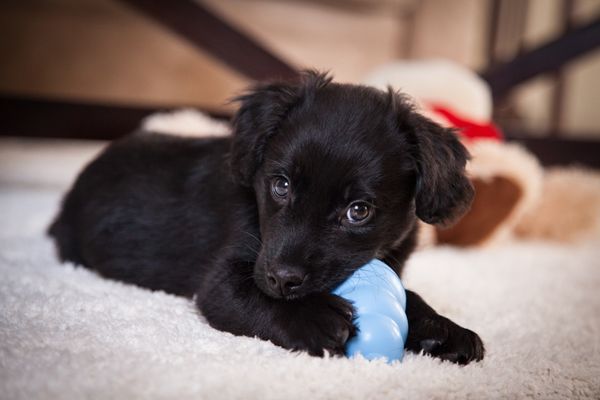 Uh oh. Last week it was the couch cushions. This week another shoe got destroyed by your dog.
Uh oh. Last week it was the couch cushions. This week another shoe got destroyed by your dog.
What is it with dogs and chewing?
Chewing = Touching
People touch things with their hands to learn about an object’s texture. Dogs use their mouths to feel an object. What appears to be chewing may be, in fact, “mouthing.”
5 Reasons Dogs Chew Stuff
- Teething – Puppies aged 3-to-6 months chew on everything they can sink their baby teeth into.
- Playing – When dogs play, they love to bite and carry objects.
- Boredom – Dogs who don’t get enough physical or mental stimulation chew to release pent-up energy.
- Hunger – Dogs on a calorie-restricted diet may chew or gnaw because they’re searching for something to eat.
- Separation Anxiety – Destructive chewing can be a result of a dog getting distressed or agitated when pet parents leave home.
How to Deal With Inappropriate Chewing
Chewing is a normal dog behavior, and if you exercise your dog daily and give him plenty of playtime, social stimulation, and appropriate chew toys, excessive chewing will often disappear.
However, chewing can sometimes be associated with a behavioral problem. If you notice excessive or destructive chewing, start a “chew journal.” For one week, note and/or videotape times of day your dog chews, what he chews, and what’s going on in his environment that could be causing the chewing.
Make an appointment with your veterinarian and bring your chew journal, which will help us determine what may be triggering the inappropriate chewing.
Dogs can’t tell the difference between old socks and new socks! Don’t give your dog old socks or shoes to chew, as that will train him to chew all socks and shoes.
To help prevent temptation, dog-proof your home by storing items you don’t want him to chew out of reach. When you’re away from home, crate your dog or confine him in a safe area.
Don’t reward your dog for inappropriate chewing. It sounds like a no-brainer, but some pet parents who catch their dog gnawing a table leg scold the dog and then give him a doggie treat. When you do this, you’re rewarding and encouraging the behavior. Instead, get your dog’s attention, and then redirect him to his favorite chew toy. Praise him when he begins playing with the toy.
Dogs don’t have a sense of time like humans do, so when you come home and discover that your pup has destroyed your favorite pair of jeans, don’t yell, spank, swat, or punish him. Your dog will have no idea what he’s being reprimanded for.
Your veterinarian will acquaint you with behavior modification training and other products that will help you safely deter destructive chewing.
Supervise your dog closely. When you spot your dog chewing an approved chew toy, praise him. This teaches him that it’s not wrong to chew, and trains him about the types of things he is encouraged to chew.
Chew Toys to Avoid
It’s important NOT to give your dog a chew toy that is harder than his teeth, as carnivore teeth are not designed to chew bones or other objects harder than the teeth. These objects can break your dog’s teeth and cause the gums to become infected.
Never give your dog cooked or uncooked bones, antlers, hard and thick rawhides, plastic or nylon bones, or large ice cubes.
Flatter, softer rawhide chews are safer for your dog’s teeth and can be effective in reducing plaque accumulation.
Also avoid giving him tennis balls, Frisbees, and other objects with abrasive surfaces, as they have a sandpaper-like effect on your dog’s teeth.
How Hard is Too Hard?
Here are some ways you can quickly determine whether a toy is too hard for your dog to chew.
- Tap the chew toy against your knee. If it hurts, it’s too hard for your dog.
- Test the chew toy as a hammer. If you can use it to drive a nail into something, it’s too hard for your dog.
- Use your fingernail to indent the surface of the toy. The surface needs to have some “give.”
- Flex or break the chew toy with your bare hands (after buying it, of course). If you can’t flex it or break it, it’s too hard for your dog.
Appropriate Chew Toys for Your Dog
Provide lots of chew toys, particularly if you have a teething puppy. Try a variety of shapes, textures, colors, and odors and your dog will find a favorite.
KONG and West Paw both make a wide variety of chew toys, including balls, flying discs, squishy, squeaky, floppy, knotted, plush, durable bones, dental, teething, tug-of-war, fetch-and-retrieve, and more.
KONG organizes chewing styles into four categories:
- Teething chewer
- Average chewer
- Power chewer
- Aging chewer
They also provide a handy size guide that matches chew toys to a dog’s weight.
West Paw organizes toys according to three chewing and play levels:
Treat-Filled Chew Toys
Many chew toys can be stuffed with tasty treats to encourage chewing as needed. You can coat or fill a chew toy with peanut butter, cheese spread, canned dog food, and/or dog kibble. You can feed a portion of your dog’s regular diet from a chew toy. If your dog is removing the food too quickly, you can place the filled toy in the freezer before offering.
Click this link for chew toy filler recipes.
Here’s a recipe called Fido’s Farmhouse Feast.
Three important things to remember:
- Make sure all rawhide chews and chew toys are an appropriate size for your dog’s weight.
- Monitor your dog when he’s chewing to prevent ingestion of the toys (or of large pieces of a rawhide chew).
- Rotate chew toys every few days to add variety.
Download this handy list of chew toys approved by the Veterinary Oral Health Council (VOHC). You’ll find rawhide chews, dental care chews, and edible chew treats in various flavors.





